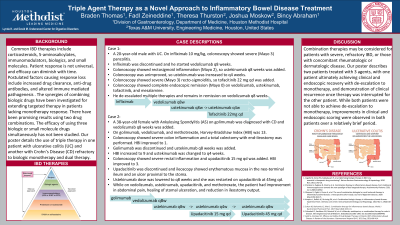Tuesday Poster Session
Category: IBD
P4433 - Triple Agent Therapy as a Novel Approach to Inflammatory Bowel Disease Treatment
Tuesday, October 29, 2024
10:30 AM - 4:00 PM ET
Location: Exhibit Hall E

Has Audio
- BT
Braden Thomas, MD
Houston Methodist Hospital
Baltimore, MD
Presenting Author(s)
Braden Thomas, MD1, Fadl Zeineddine, MD2, Theresa Thurston, BS3, Joshua Moskow, BS3, Bincy P. Abraham, MD, MS, FACG4
1Houston Methodist Hospital, Baltimore, MD; 2Houston Methodist Hospital, Houston, TX; 3Texas A&M School of Medicine, Houston, TX; 4Houston Methodist-Weill Cornell, Houston, TX
Introduction: Inflammatory Bowel Disease (IBD) therapies include corticosteroids, 5-aminosalicylates, immunomodulators, biologics, and small molecules. Our case report details the use of triple biologic therapy in a patient with Ulcerative Colitis (UC) and another with Crohn’s Disease (CD) refractory to biologic monotherapy and dual therapy.
Case Description/Methods: A 20-year-old male with UC. On infliximab 10 mg/kg, colonoscopy showed severe (Mayo 3) pancolitis. Infliximab was discontinued and he started vedolizumab q8 weeks. Colonoscopy showed rectosigmoid inflammation (Mayo 2), so ustekinumab q8 weeks was added. Colonoscopy was unimproved, so ustekinumab was increased to q4 weeks. Colonoscopy showed severe (Mayo 3) recto-sigmoiditis, so tofacitinib 22 mg qd was added. Colonoscopy showed complete endoscopic remission (Mayo 0) on vedolizumab, ustekinumab, tofacitinib, and mesalamine. He de-escalated multiple therapies and remains in remission on vedolizumab q8 weeks.
A 38-year-old female with Ankylosing Spondylitis (AS) on golimumab was diagnosed with CD and vedolizumab q8 weeks was added. On golimumab, vedolizumab, and methotrexate, Harvey-Bradshaw Index (HBI) was 13. Colonoscopy showed severe colon inflammation and a total colectomy with end-ileostomy was performed. HBI improved to 1. Golimumab was discontinued and ustekinumab q8 weeks was added. HBI increased to 9 and ustekinumab was changed to q4 weeks. Colonoscopy showed severe rectal inflammation and upadacitinib 15 mg qd was added. HBI improved to 3. Upadacitinib was discontinued and ileoscopy showed erythematous mucosa in the neo-terminal ileum and an ulcer proximal to the stoma. Ustekinumab dose was lowered to q8 weeks and she was restarted on upadacitinib at 45mg qd. While on vedolizumab, ustekinumab, upadacitinib, and methotrexate, the patient had improvement in abdominal pain, healing of stomal ulceration, and reduction in ileostomy output.
Discussion: Combination therapies may be considered for patients with severe, refractory IBD, or those with concomitant rheumatologic or dermatologic disease. Our case report describes two patients treated with 3 agents, with one patient ultimately achieving clinical and endoscopic recovery with de-escalation to monotherapy, and demonstration of clinical recurrence once therapy was interrupted for the other patient. While both patients were not able to achieve de-escalation to monotherapy, improvements in clinical and endoscopic scoring were observed in both patients over a relatively brief period.
Disclosures:
Braden Thomas, MD1, Fadl Zeineddine, MD2, Theresa Thurston, BS3, Joshua Moskow, BS3, Bincy P. Abraham, MD, MS, FACG4. P4433 - Triple Agent Therapy as a Novel Approach to Inflammatory Bowel Disease Treatment, ACG 2024 Annual Scientific Meeting Abstracts. Philadelphia, PA: American College of Gastroenterology.
1Houston Methodist Hospital, Baltimore, MD; 2Houston Methodist Hospital, Houston, TX; 3Texas A&M School of Medicine, Houston, TX; 4Houston Methodist-Weill Cornell, Houston, TX
Introduction: Inflammatory Bowel Disease (IBD) therapies include corticosteroids, 5-aminosalicylates, immunomodulators, biologics, and small molecules. Our case report details the use of triple biologic therapy in a patient with Ulcerative Colitis (UC) and another with Crohn’s Disease (CD) refractory to biologic monotherapy and dual therapy.
Case Description/Methods: A 20-year-old male with UC. On infliximab 10 mg/kg, colonoscopy showed severe (Mayo 3) pancolitis. Infliximab was discontinued and he started vedolizumab q8 weeks. Colonoscopy showed rectosigmoid inflammation (Mayo 2), so ustekinumab q8 weeks was added. Colonoscopy was unimproved, so ustekinumab was increased to q4 weeks. Colonoscopy showed severe (Mayo 3) recto-sigmoiditis, so tofacitinib 22 mg qd was added. Colonoscopy showed complete endoscopic remission (Mayo 0) on vedolizumab, ustekinumab, tofacitinib, and mesalamine. He de-escalated multiple therapies and remains in remission on vedolizumab q8 weeks.
A 38-year-old female with Ankylosing Spondylitis (AS) on golimumab was diagnosed with CD and vedolizumab q8 weeks was added. On golimumab, vedolizumab, and methotrexate, Harvey-Bradshaw Index (HBI) was 13. Colonoscopy showed severe colon inflammation and a total colectomy with end-ileostomy was performed. HBI improved to 1. Golimumab was discontinued and ustekinumab q8 weeks was added. HBI increased to 9 and ustekinumab was changed to q4 weeks. Colonoscopy showed severe rectal inflammation and upadacitinib 15 mg qd was added. HBI improved to 3. Upadacitinib was discontinued and ileoscopy showed erythematous mucosa in the neo-terminal ileum and an ulcer proximal to the stoma. Ustekinumab dose was lowered to q8 weeks and she was restarted on upadacitinib at 45mg qd. While on vedolizumab, ustekinumab, upadacitinib, and methotrexate, the patient had improvement in abdominal pain, healing of stomal ulceration, and reduction in ileostomy output.
Discussion: Combination therapies may be considered for patients with severe, refractory IBD, or those with concomitant rheumatologic or dermatologic disease. Our case report describes two patients treated with 3 agents, with one patient ultimately achieving clinical and endoscopic recovery with de-escalation to monotherapy, and demonstration of clinical recurrence once therapy was interrupted for the other patient. While both patients were not able to achieve de-escalation to monotherapy, improvements in clinical and endoscopic scoring were observed in both patients over a relatively brief period.
Disclosures:
Braden Thomas indicated no relevant financial relationships.
Fadl Zeineddine indicated no relevant financial relationships.
Theresa Thurston indicated no relevant financial relationships.
Joshua Moskow indicated no relevant financial relationships.
Bincy P. Abraham: AbbVie – Consultant, Speakers Bureau. Bristol Myers Squibb – Consultant, Speakers Bureau. Celltrion – Consultant. Eli Lilly – Consultant, Speakers Bureau. Fresenius Kabi – Consultant. Janssen – Consultant, Speakers Bureau. Medtronic – Consultant. Pfizer – Consultant, Speakers Bureau. Prometheus – Consultant. Samsung Bioepis – Consultant. Takeda – Consultant, Speakers Bureau.
Braden Thomas, MD1, Fadl Zeineddine, MD2, Theresa Thurston, BS3, Joshua Moskow, BS3, Bincy P. Abraham, MD, MS, FACG4. P4433 - Triple Agent Therapy as a Novel Approach to Inflammatory Bowel Disease Treatment, ACG 2024 Annual Scientific Meeting Abstracts. Philadelphia, PA: American College of Gastroenterology.
